Over the last 25 years, hemlock and ash populations have been devastated by invasive pests. This project, rooted in the latest research, focuses on protecting the remaining hemlock and ash trees through early interventions, biologic controls (predators that target the invasive pests), and insecticide treatments.
Project Title: Hanging On – Saving the Park’s Hemlock and Ash Trees
Project Purpose: to protect and preserve Hemlock and Ash trees from the serious threat from the invasive emerald ash borer (EAB) and hemlock woolly adelgid (HWA).
Project Goals:
- to preserve a portion of the park’s eastern hemlocks for future restoration and until biological controls (Laricobius predatory beetles) can become established
- to retain ash trees for visitor enjoyment, reduce threats to visitors from hazard tree formation, and to preserve a portion of the park’s ash tree communities until host-specific biological controls become available
Project Impact: In the past 25 years, HWA has killed 95% of Shenandoah’s hemlock trees, and without treatment, the EAB is likely to kill over a million ash trees in the park in the next 7-10 years. With proper funding to treat these trees, the park will conduct HWA and EAB suppression in targeted areas throughout the park. Approximately 2,200 hemlocks would be protected via HWA soil treatments. Approximately 140 ash trees were hand-treated in 2022 (using emamectin benzoate/Mectinite® that is absorbed by the tree) and monitor treated trees.
Project Funding: $33,000
Check out this blog post about releasing laricobius beetles in the Limberlost area!
Is it working? A Deep Dive on Treating Hemlock Woolly Adelgid in Shenandoah National Park
“The Orphan Cohort” – Protecting the next generation of Ash Trees in Shenandoah National Park
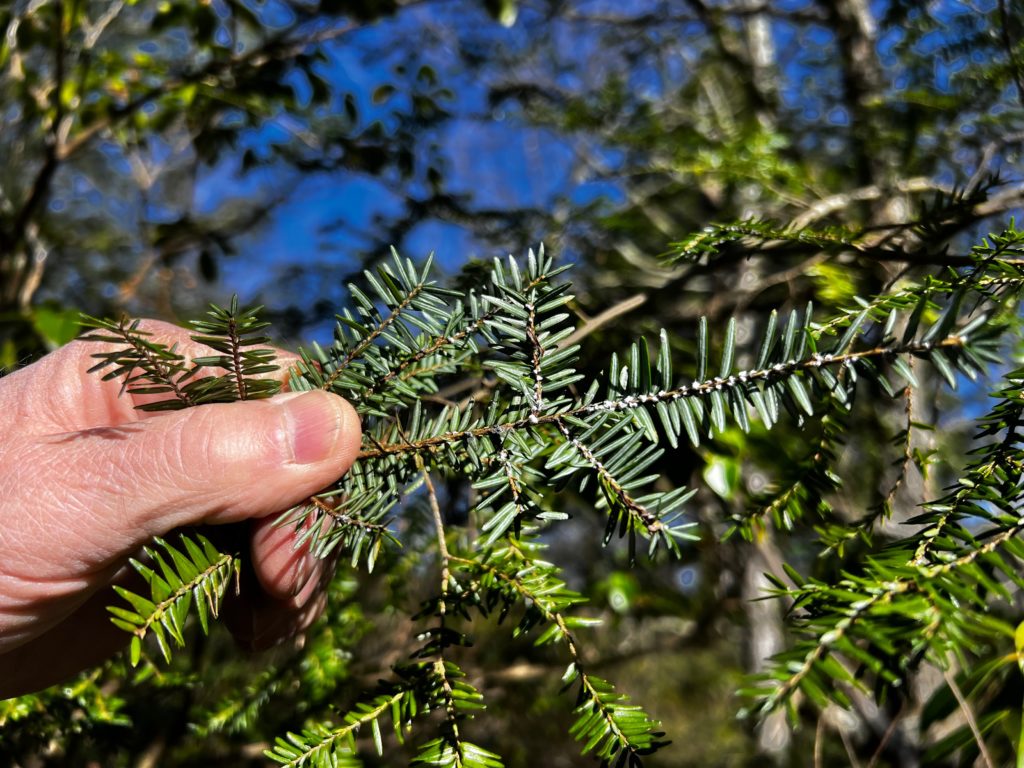
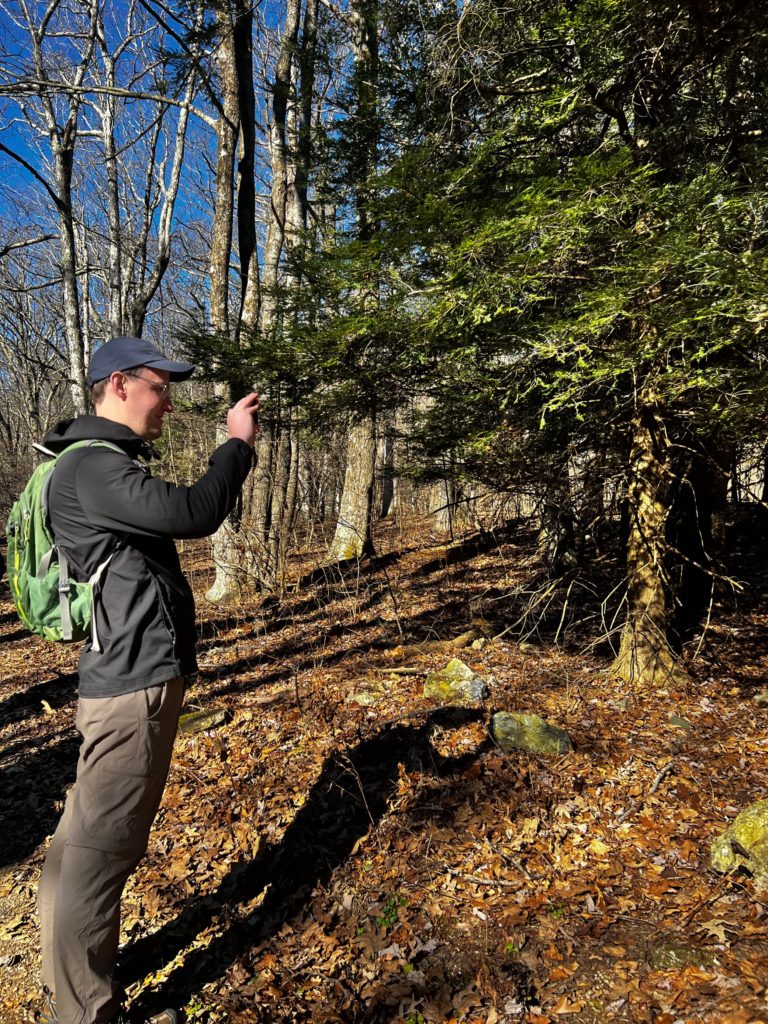
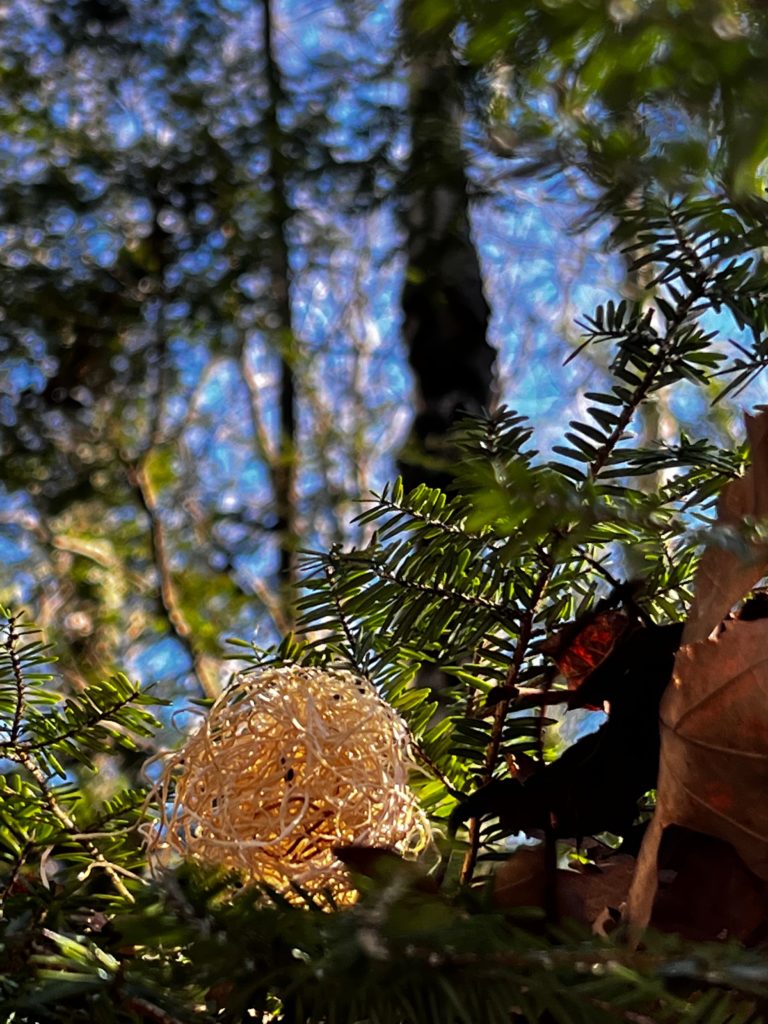
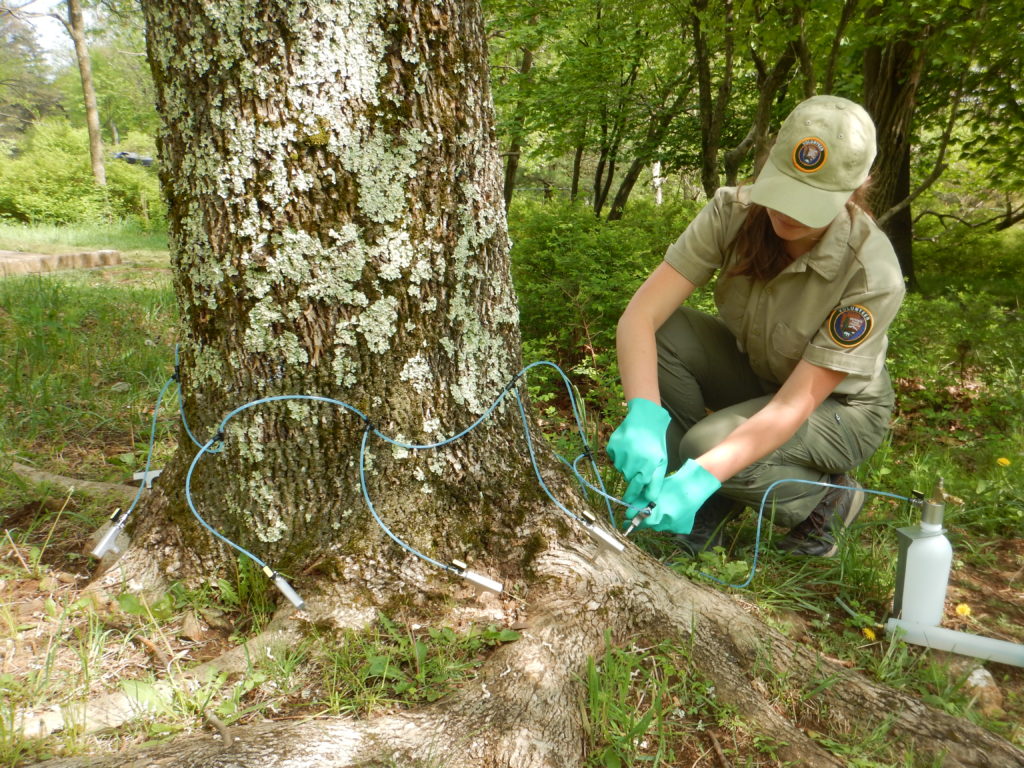
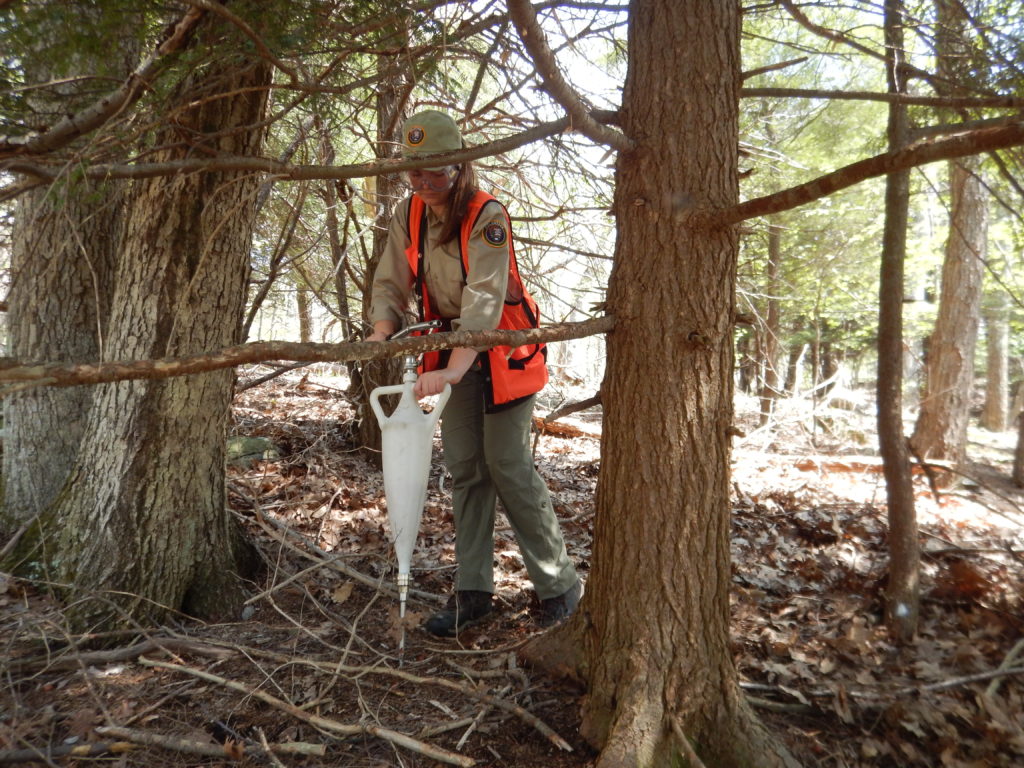
Project Progress:
- 2024
- HWA
- Staff treated 2123 hemlocks using soil treatments with imidacloprid to protect against HWA. Data were collected on all trees.
- Worked with VA Tech (S. Salom) to successfully release 699 Laricobius predatory beetles at two Central District sites.
- Park staff released 2229 predatory Leucotaraxis silver flies at Rapidan Camp & Big Run.
- EAB
- Staff treated 282 ash trees with stem injections of emamectin benzoate to protect against EAB. Treatments included primarily South District trees that had the potential to become hazardous. Trees were inventoried and mapped.
- Worked with USDA-APHIS to release 9195 parasitic wasps at three sites to control EAB.
- HWA
- 2023
- HWA
- Staff worked with Virginia Tech and SNP volunteers to successfully release 2700 Laricobius predatory beetles at six sites in the Central District (mid to late November). Beetles were collected by Virginia Tech staff from hemlocks in Southwest VA.
- VA Tech staff and Dale Meyerhoeffer released 240 Leucotaraxis silver flies, predators of HWA eggs, at Skyland and Madison Run in March and April (funded by VA Tech).
- Staff scouted probable Nov 2023 Laricobius release sites at White Oak Canyon, West Branch Naked Creek (lower section/near boundary & upper section on new SNPT Tract), and lower Big Run in the South District.
- Laricobius surveillance monitoring (beat sheet sampling) was conducted at Madison Run and Weakley Hollow. Laricobius beetles were recovered at both sites indicating good establishment.
- EAB
- The vast majority (~99%) of ash trees treated with emamectin benzoate within the last five years have remained healthy and have shown stable crown health.
- Staff and volunteers were able to treat 235 ash trees with emamectin benzoate (MectiniteTM) stem injections sites mostly in the North District.
- HWA
- 2022
- HWA
- On average, hemlock sites re-treated in 2022 had improved about 10% in crown health since their initial treatment.
- 3,309 hemlocks (298 acres) were treated at Weakley Hollow, Gap Run, Park Headquarters, Jollet Hollow, Overall Run, Graves Mill, Huckleberry Cliff, Piney Branch, Mill Prong and Robertson Mt. with imidacloprid soil injections. Data was collected on all trees. 1,313 of these trees were previously untreated.
- Staff worked with Virginia Tech to successfully release 1,108 Laricobius predatory beetles at Gap Run and Ivy Creek sites. Beetles were collected from hemlocks in Southwest VA.
- Laricobius surveillance monitoring was conducted at 3 previous release sites (Madison Run, South Fork of the Moormans, Meadow Run) where the beetles showed positive signs of establishment and dispersal.
- EAB
- Staff plus volunteers were able to treat 350 ash trees with stem injections at Loft Mountain Campground and three other locations.
- The vast majority (~99%) of ash trees treated with emamectin benzoate within the last four years have remained healthy and have shown stable crown health.
- HWA
- 2021
- HWA
- 3,224 hemlocks (297 acres) were treated at Cat Knob, South Fork Moormans, Crow Hollow, Nicholson Hollow, Trayfoot/Blackrock, Pass Run, and Pinnacles with imidacloprid soil injections. Data was collected on all trees. 1,059 of these trees were previously untreated.
- In March, staff worked with VA Tech staff to release 342 Laricobius nigrinus predatory beetles at the Weakley Hollow release site. These beetles were wild-harvested from hemlocks in Southwest VA.
- SNP Trust funded park biologists, working alongside Virginia Tech’s Hemlock Preservation Foundation, to purchase 500 predatory (biocontrol) beetles for release at a suitable hemlock site.
- In HWA treatment areas, hemlock crown health remained stable or improved in 2021.
- EAB
- Staff and volunteers worked 52 workdays to treat 235 ash trees with injections of emamectin benzoate for EAB suppression. Treated trees were inventoried & mapped.
- HWA
- 2020
- HWA
- 2,171 hemlocks (775.9 acres) were treated at Big Meadows, along Thornton River, and The Sag with imidacloprid soil injections (Zenith 75WSP). Data was collected on all trees. ~300 of these trees were previously untreated. Trainees included 6 interns and volunteers.
- Staff worked with Virginia Tech staff to release 500 Laricobius nigrinus predatory beetles at the Meadow Run release site in the South District.
- EAB
- Staff and volunteers/interns treated 212 ash trees with injections of emamectin benzoate for EAB suppression.
- Treated trees included primarily North District developed area trees that had the potential to become a hazard.
- HWA
- 2019
- HWA
- Park staff treated 2,305 eastern hemlocks with imidacloprid soil injections.
- 914 new, previously untreated eastern hemlocks were inventoried, mapped, and treated.
- Staff worked with Virginia Tech staff to release 500 Laricobius nigrinus predatory beetles at the Meadow Run release site. These biocontrol beetles will eventually help to suppress HWA populations in these areas. Staff monitored Laricobius osakensis populations at two release sites using beat sheet sampling. Three adult L. osakensis were recovered at Madison Run and none were recovered at the South Fork of the Moormans site.
- EAB
- Staff treated 343 ash trees with stem injections.
- Staff coordinated five volunteer events for the Loft Mt. Campground EAB suppression Project. During these events, our staff provided EAB suppression training for 4 Biological Technicians, 3 Interns, 4 Volunteers, and 8 state and local cooperators.
- HWA
- 2018
- HWA
- Park staff treated 2,841 hemlock trees at three sites using imidacloprid soil treatments to a fairly large genetic pool. These areas included the Stony Man, Rapidan, and Staunton River Areas.
- In November 2017, SHEN and VA Tech staff released 500 predatory beetles in the South District boundary area of the park near the Charlottesville Reservoir and the lower South Fork of the Mormons River. These beetles (Laricobius osakensis) are host-specific bio-controls used to suppress HWA in areas that are not treated with imidacloprid.
- In HWA treatment areas, hemlock crown health remained stable or improved in 2018.
- EAB
- In May/June 2018, staff treated 100 ash trees with stem injections. Developed Area ash trees that had the potential to become hazard trees were targeted for treatment.
- Areas in the Central/Southern portions of the Park were targeted because developed area ash trees are at greatest risk there. Staff found that insecticide uptake was sometimes slow depending on time of day and varying environmental conditions.
- HWA
- 2017
- HWA
- Park staff treated 2,292 hemlock trees at two sites using soil treatments with CoreTect imidacloprid tablets.
- Staff treated 697 trees on 11 gross acres at Big Devils Stairs Area and 1,595 trees on 62 gross acres at Stony Man Area. Approximately 9.3 acres of forest canopy is occupied by the treated trees.
- EAB
- Additionally, in April and May, 2017, staff treated 67 ash trees with stem injections of TREE-age (active ingredient emamectin benzoate) using the Tree IV system.
- Potential hazard trees in developed areas were targeted for treatment. These areas included Dickey Ridge Picnic Area, Gravel Springs Hut, Matthews Arm Campground, Range View Cabin, Elkwallow Wayside and Picnic Area, Pass Mt. Hut, Panorama, Buck Hollow Trail Head, Meadow Spring Trailhead, Pinnacles Picnic Area, Pinnacles Research Lab, and Rapidan Camp. Areas in the Northern half of the Park were targeted because ash trees are at greatest risk there. Staff found that insecticide uptake was often very slow, especially before full leaf-out.
- HWA
